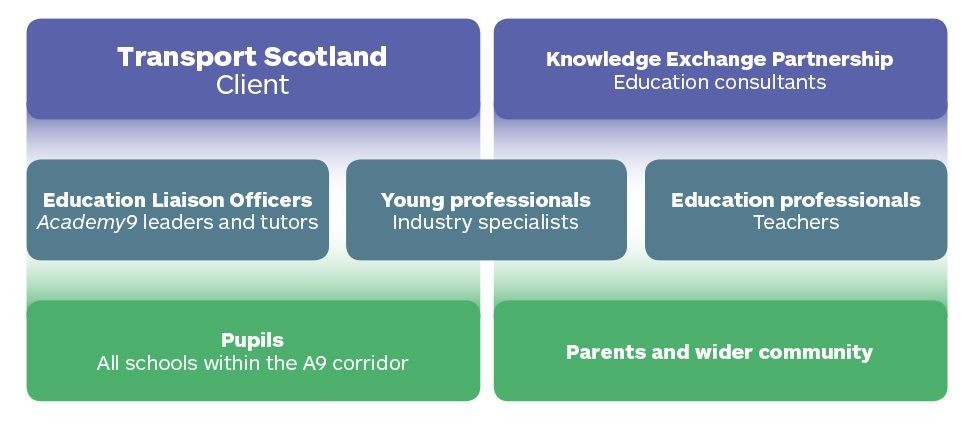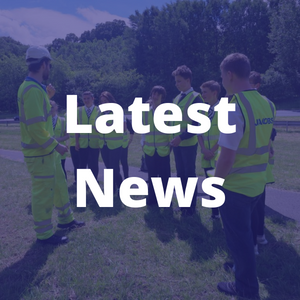
The strength of education-industry partnerships lies in the mutual exchange and integration of knowledge and expertise.
Partnerships may involve particular schools, colleges, industry bodies, businesses or employers, or other organisations.
A genuinely collaborative and integrative partnership should draw its personnel from both education and industry including, for example, education practitioners of various backgrounds (e.g. teachers, careers officers, DYW staff) and industry professionals (e.g. with backgrounds in STEM subjects).
The commitment of senior personnel (e.g. from boards of management, education management teams) is essential.
Contacts and networks
Planning and preparation should include thinking about your partnerships – who to involve, what structures to put in place, what working practices to adopt.
There may be local (or national) contacts and networks that provide clear opportunities for partnership; you may already be in partnerships which can be replicated or extended.
Make use of existing knowledge about local individuals and networks to develop new contacts and professional relationships, to establish who the strategic players are within those networks and different ways you can promote awareness of your education programme.
Preparing for partnerships
Allow time to create your partnerships. Senior authorisation (perhaps through committees) may be needed and legal agreements or contracts may have to be drawn up in advance of any approved implementation.
Local authorities, senior managers and others may have to be contacted/visited by the delivery team. If needed, prepare promotional materials for your education programme (e.g. leaflets, a video) or make use of your framework document to raise awareness. Face-to-face contact can be beneficial with individuals who might play key roles on an everyday basis. Make sure you have senior managers on side, as well as e.g. classroom teachers.
Be clear about the roles and expectations of each partner. What will you offer? What level of commitment is expected in return? Be prepared to give details of – and be open about – your proposals.
- Do you have a particular target audience in mind?
- Do you have details of the types of learning events and challenges planned?
- About the physical settings needed for these?
- About the participation of classroom teachers in activities?
- About the amount of time commitment involved?
Be respectful of professional variations. Industry or business professionals bring subject expertise as well as personifying particular career pathways; they may have different working routines and practices and perhaps different expectations of the skills that young people should possess. Education professionals have knowledge about individuals within class groups, expertise in the curriculum and in learning and teaching, as well as skills in class management. Recognising each other’s strengths is important for consolidating your partnership(s).
It is important that relationships of respect and trust are established quickly. An open approach, willingness to share information, a readiness to listen, ask and invite questions, negotiate and compromise on points of disagreement, etc. are all means for building rapport and feelings of joint ownership.
Partnership structures
A management or steering group with representation from all partners helps support and sustain the overall vision and co-ordination of the programme. With its overarching supervision, it can provide a focus – e.g. for long-term planning, strategic decision-making, authorisation of expenditure, etc. There is also a need for an operational group – comprising, for example, members of the delivery team – to provide a forum for reflection, discussion and everyday improvements.
A delivery team ideally comprising both education and industry professionals builds rapport and opportunities for both sides to gain understanding of the other. The composition of the delivery team may impact directly on the content and format of the education programme, so it is important to have a clear understanding in advance of what you want that programme to look like, so you can shape the team.
Programme participants – participants in the programme will include young people (perhaps of different ages/year groups), classroom teachers/academics, head teachers/department heads, teaching assistants, and members of the delivery team (i.e. the education/industry professionals).
An example of a partnership structure
Image to be used:

Building Sustainable Partnerships
The sustainability of your partnership(s) depends on a number of factors:
- A shared vision for the programme
- Recognition and acceptance of different professional perspectives
- A willingness to share responsibilities
- Relationships of openness, respect and trust.
Sustainability can also be measured in terms of legacy. An effective education programme will have impacts that endure beyond its own lifetime and partnerships should acknowledge and prepare for this.
Legacy planning should be embedded in the early stages of creating your programme.
What longer-term influences might your programme have? And how can this potentiality be facilitated?
Adopting a forward-thinking perspective within the partnership will generate a momentum to the programme, enhancing and strengthening its impact.
An effective programme is one that contributes to change and improvement – for example, teachers finding new ways of thinking for delivering their lessons; young people adopting different attitudes or approaches, developing new skills and capabilities; increasing the alignment of the national education curriculum with the work-relevant needs of employers and the economy.
References
For further information about education-industry partnerships see Education Scotland/Smarter Scotland (2015), Developing the Young Workforce – School/Employer Partnerships, Edinburgh: The Scottish Government.




